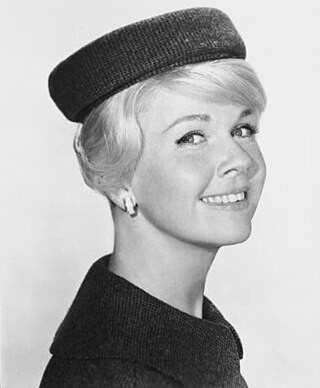
Doris Day was an American actress and singer. She began her career as a big band singer in 1937, achieving commercial success in 1945 with two No. 1 recordings, "Sentimental Journey" and "My Dreams Are Getting Better All the Time" with Les Brown and His Band of Renown. She left Brown to embark on a solo career and recorded more than 650 songs from 1947 to 1967.

Francis Albert Sinatra was an American singer and actor. Nicknamed the "Chairman of the Board" and "Ol' Blue Eyes", he is regarded as one of the most popular entertainers of the 20th century. Sinatra is among the world's best-selling music artists, with an estimated 150 million record sales globally.
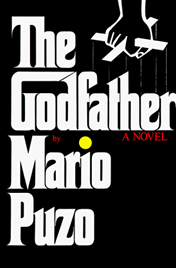
The Godfather is a crime novel by American author Mario Puzo. Originally published on 10 March 1969 by G. P. Putnam's Sons, the novel details the story of a fictional Mafia family in New York City and Long Island, headed by Vito Corleone: the Godfather. The novel covers the years 1945 to 1955 and includes the backstory of Vito Corleone from early childhood to adulthood.
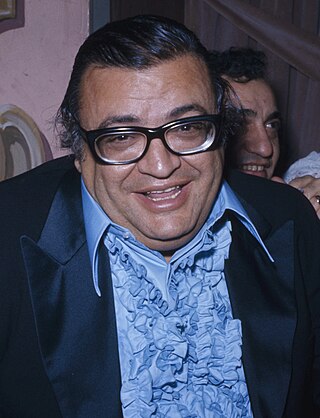
Mario Francis Puzo was an American author and screenwriter. He wrote crime novels about the Italian-American Mafia and Sicilian Mafia, most notably The Godfather (1969), which he later co-adapted into a film trilogy directed by Francis Ford Coppola. He received the Academy Award for Best Adapted Screenplay for the first film in 1972 and for Part II in 1974. Puzo also wrote the original screenplay for the 1978 Superman film and its 1980 sequel. His final novel, The Family, was released posthumously in 2001.
Michael Kidd was an American film and stage choreographer, dancer and actor, whose career spanned five decades, and who staged some of the leading Broadway and film musicals of the 1940s and 1950s. Kidd, strongly influenced by Charlie Chaplin and Léonide Massine, was an innovator in what came to be known as the "integrated musical", in which dance movements are integral to the plot.

Albert Stotland Ruddy was a Canadian-American film and television producer. He produced The Godfather (1972) and Million Dollar Baby (2004), both of which won him the Academy Award for Best Picture, and co-created the CBS sitcom Hogan's Heroes (1965–1971).
Forbidden Hollywood is a parody show that opened Off-Off-Broadway and was taped live in Hollywood. It was created by Gerard Alessandrini, who also created the popular series of Off-Broadway parodies of Broadway theatre, Forbidden Broadway. But this production, instead of spoofing Broadway, lampooned popular films such as Forrest Gump, Sense and Sensibility, Pulp Fiction, Casablanca, The Wizard of Oz and Disney's Aladdin, and songs featured in them, although most of the score consists of songs from musicals used to comment on the films. It also spoofs movie stars like Tom Hanks, Keanu Reeves, Barbra Streisand, Ann-Margret and Whoopi Goldberg. A New York Times reviewer wrote that although the production had funny moments, "the tone that defines the show is a glib disaffection for Hollywood", lamenting that the show missed the opportunity to use more songs from films, and concluding: "It's fine if Mr. Alessandrini wants to see Hollywood as the enemy, but you have to know your enemy to take good aim at it."
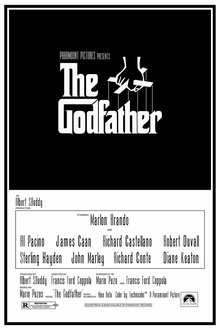
The Godfather is a 1972 American epic gangster film directed by Francis Ford Coppola, who co-wrote the screenplay with Mario Puzo, based on Puzo's best-selling 1969 novel. The Godfather is regarded as one of the greatest and most influential films ever made, as well as a landmark of the gangster genre. The film stars an ensemble cast including Marlon Brando, Al Pacino, James Caan, Richard Castellano, Robert Duvall, Sterling Hayden, John Marley, Richard Conte and Diane Keaton. It is the first installment in The Godfather trilogy, chronicling the Corleone family under patriarch Vito Corleone (Brando) and the transformation of his youngest son, Michael Corleone (Pacino), from reluctant family outsider to ruthless mafia boss.
"I Have Dreamed" is a show tune from the 1951 Rodgers and Hammerstein musical, The King and I. In the original Broadway production it was sung by Doretta Morrow and Larry Douglas. It has since become a standard, with many artists recording the song.
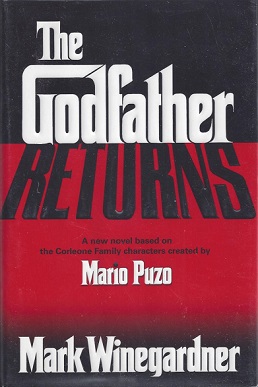
The Godfather Returns is a novel written by author Mark Winegardner, published in 2004. It is the sequel to Mario Puzo's 1969 novel The Godfather and The Sicilian (1984). The publisher, Random House, selected Winegardner to write a sequel after Puzo's death. As the original novel covered the years 1945 to 1955, and included significant backstory on Don Vito Corleone's life, Returns covers the years 1955 to 1962, and includes significant backstory on Michael Corleone's life prior to the first novel. It is the third book in The Godfather series of novels.

Osvaldo "Ozzie" Altobello is a fictional character and the main antagonist of the 1990 film The Godfather Part III. In the film, he is portrayed by Eli Wallach.

The Hoboken Four was an American musical quartet formed in 1935, uniting a trio of Italian-American musicians who called themselves the 3 Flashes with aspiring singer Frank Sinatra. The trio had been based in Hoboken, New Jersey, before meeting Sinatra in 1934, after which Sinatra drove them and their instruments to gigs outside the city and occasionally performed with them. Following their winning performance on the Major Bowes Amateur Hour on September 8, 1935, the newly formed quartet embarked on a seven-month tour of the central and western United States and Canada with one of Major Bowes' touring companies. Tensions between the quartet members escalated, however, to the point that Sinatra was regularly beaten by the other members, and he quit the tour halfway through. He returned to Hoboken to pursue a solo career, while the rest of the group disbanded after the tour ended.
The Godfather is a trilogy of American crime films directed by Francis Ford Coppola inspired by the 1969 novel of the same name by Italian American author Mario Puzo. The films follow the trials of the fictional Italian American mafia Corleone family whose patriarch, Vito Corleone, rises to be a major figure in American organized crime. His youngest son, Michael Corleone, becomes his successor. The films were distributed by Paramount Pictures and released in 1972, 1974, and 1990. The series achieved success at the box office, with the films earning between $430 and $517 million worldwide. The Godfather and The Godfather Part II are both seen by many as two of the greatest films of all time. The series is heavily awarded, winning 9 out of 28 total Academy Award nominations.
Mafia films—a version of gangster films—are a subgenre of crime films dealing with organized crime, often specifically with Mafia organizations. Especially in early mob films, there is considerable overlap with film noir. Popular regional variations of the genre include Italian Poliziotteschi, Chinese Triad films, Japanese Yakuza films, and Indian Mumbai underworld films.

American actress Doris Day appeared in 39 feature films released between 1948 and 1968. Day began her career as a band singer and eventually won the female lead in the Warner Bros. film Romance on the High Seas (1948), for which she was selected by Michael Curtiz to replace Betty Hutton. She starred in several minor musicals for Warner Bros., including Tea for Two (1950), Lullaby of Broadway (1951), April in Paris (1952), By the Light of the Silvery Moon (1953) and the hit musical Calamity Jane, in which she performed the Academy Award-winning song "Secret Love" (1953). She ended her contract with Warner Bros. after filming Young at Heart (1954) with Frank Sinatra.

William James Ahern was an American vaudeville entertainer at the beginning of the 20th century. He is best known for being part of a comedy duo with his wife, Gladys Reese Ahern. As part of their act, Ahern told jokes and performed rope tricks while his wife, using a Mexican accent, sang and danced.
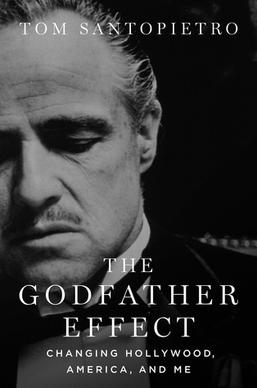
The Godfather Effect is a 2012 critically acclaimed study of The Godfather films – as well as Mario Puzo's 1969 novel – and their effect on American culture. Written by biographer Tom Santopietro, the book demonstrates how The Godfather was a turning point in American cultural consciousness. With its emphasis on proud ethnicity, The Godfather changed not just the way Italian-Americans saw themselves, but how Americans of all backgrounds viewed their individual and national self-identities, their possibilities, and attendant disappointments.

Alan Bergman and Marilyn Keith Bergman were an American songwriting duo. Married from 1958 until Marilyn's death, together they wrote music and lyrics for numerous celebrated television, film, and stage productions. The Bergmans enjoyed a successful career, honored with four Emmys, three Oscars, and two Grammys. They are in the Songwriters Hall of Fame.

Frank Sinatra was a strong supporter and activist for Jewish causes in the United States and Israel. According to Santopietro, Sinatra was a "lifelong sympathizer with Jewish causes". Sinatra participated in Hollywood protests and productions supporting Jews during the Holocaust and the formation of the State of Israel. He actively fund-raised for Israel Bonds, the Hebrew University of Jerusalem, and the Simon Wiesenthal Center, and helped establish two intercultural centers in Israel which bear his name. Due to his support of Israel, his recordings and films were banned by the Arab League and by Lebanon.













